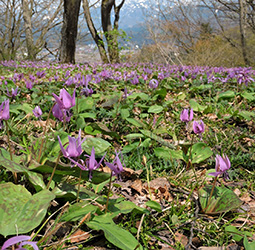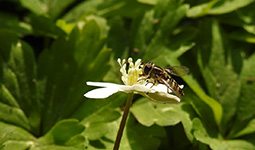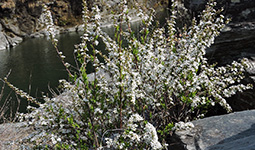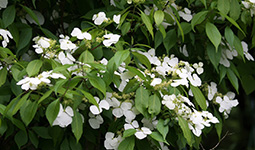April 2022
- PREVIOUS
- NEXT
- English
- 日本語
The Flowers that Give Color to Japanese Spring

Tada Taeko 
Flowers of egonoki called Japanese snowbell

Katakuri (Japanese dogtooth violet) flowers in satoyama in Niigata Prefecture 
A hirataabu (a variety of hoverfly) eating the pollen of nirinso (soft windflower) 
Yukiyanagi (Thunberg’s meadowsweet) blooming in white on the banks of the Arakawa River in Saitama Prefecture 
Gakuutsugi, a flower in the hydrangea family, on Mt. Takao in Tokyo

Many kinds of flowers bring color to the fields and mountains of Japan in spring. We spoke with Tada Taeko, a plant ecologist who is a lecturer at Rikkyo University and other universities, about spring flowers in Japan.

In Japan, various flowers such as cherry blossoms bloom in spring, but how many types are there? Also, please tell us about their characteristics.
More than 7,400 species of land plants grow naturally in Japan. Of these, there are more than 5,000 species of flowering plants and about 1,500 kinds of endemic species that can only be found in Japan, including fukujuso (Amur adonis), fuji (wisteria), asebi (Japanese andromeda) and yamazakura (Japanese mountain cherry) that bloom in spring. Japan is one of the richest countries in terms of biological diversity including plants, and is one of the most important “hot spots” in terms of global biodiversity.
Japan is an island nation, consisting of numerous islands. In general, organisms on islands evolve independently and become species unique to that island. Among the islands of the Japanese archipelago, there are those such as the Ogasawara Islands that have never been connected to the continent, while others, such as the Ryukyu archipelago, have undergone a history of migration and isolation of organisms as a result of their transition of connection to and separation from the continent. This geohistory is also deeply related to the geographic distribution and species differentiation of organisms unique to the Japanese archipelago.
The Japanese archipelago, which extends from north to south, has regions with various climates, from Hokkaido, which belongs to the subarctic zone (high mountain areas belong to the frigid zone), to Okinawa and the Ogasawara Islands, which belong to the subtropical zone. Some areas experience very high snowfall. The terrain is full of change, with low-elevation flatlands and mountain ranges of over 3,000 meters. In addition to this diverse climate and topography, there is abundant water to support the life of various organisms.
These organisms support each other. For example, for insect-pollinated flowers, pollinators such as bees and butterflies are important partners. Plants produce pollen and nectar, and attract insects to this food source with their flowers’ color and scent. Pollen sticks to the feeding insect’s body. When the insect flies from flower to flower, pollen sticks to the stigma and causes flowers to bear fruit and produce seeds. There are also wind-pollinated plants, but insect-pollinated plants bloom with more showy flowers because these flowers have coevolved with the pollinators. Flowers have evolved their color, shape and size to be ideally suited to pollinators. In Japan, about 70 percent of flowering plants are insect-pollinated, and their color and shape have rich variety. This is closely related to the high diversity of pollinators in Japan.
At the same time, there are places in Japan where people are deeply involved in maintaining the diversity of plants and other organisms. These are areas called satoyama consisting of villages, forests, farmland, reservoirs, and so forth. In satoyama, the growth environment with a rich biodiversity has been maintained by people’s sustainable use of nature over a long time. In satoyama, forest trees are cut every 20 to 30 years to be used as fuel, while fallen leaves are collected to fertilize the fields. As a result, light comes to shine on the forest ground, thus assisting the growth of various plants such as “spring ephemerals” that appear on the ground only for a short period of time in spring. There are many beautiful flowers in full bloom there in spring.
Please tell us about what plants bloom in satoyama in spring, other than well-known flowers such as cherry and plum blossoms.
For example, there is katakuri (Japanese dogtooth violet). Dogtooth violet is one of the spring ephemerals. For a short period of time in spring, after sprouting, producing leaves, blooming, and making seeds, it withers and disappears almost without a trace. Only the seeds and bulbs left behind wait in the ground for the next spring to come.

Each dogtooth violet blooms with one purple pink flower repeatedly opening and closing for about a week. The flower is closed at night and during cold days but becomes wide open during warmer days. While it grows widely from Hokkaido to Kyushu, there are beautiful colonies in heavy snow areas such as Hokkaido, the Tohoku region and Niigata Prefecture. Scenes of satoyama with Japanese dogtooth violets in full bloom after the snow melts are very beautiful.
I often liken the relationship between flowering plants and insects to the relationship between restaurants and customers. The “meal” provided by the flowers is pollen and nectar, and the “price” insects pay is the transport of pollen. Some restaurants are exclusive, while others are casual restaurants for everyone. The same is true for plants. The dogtooth violet can be said to be a plant that is regarded as a “high-end restaurant-type” that serves specific customers, such as bumblebees and gifucho (Japanese luehdorfia, a kind of butterfly). This can be seen from the purple pink color of the dogtooth violet flower, since insects generally tend to like white and yellow colors, and moreover because the flower faces downwards, making it difficult for weak-legged insects to perch on the flowers. Bumblebees and gifucho not only have the physical ability to perch, but also memorize the color, shape and location of flowers very well, allowing them to choose the same kind of flower as they fly around from one to another. In other words, it’s a highly efficient way for these flowers to transport pollen.
On the other hand, “casual restaurant-type” plants attract a wide variety of insects, which then fly around to many flowers carrying the plants’ pollen. Such plants have bright colors, such as white or yellow, in line with the instinct of insects to generally fly toward what is bright. Moreover, the structure of the flowers is simple so that even insects unable to fly well or insects with short tongues can easily perch on the flowers and suck their nectar.
An example of a spring ephemeral that is a casual restaurant-type plant is nirinso (soft windflower) with its white flowers. The soft windflower blooms facing upward, so it is easy for insects to perch. This allows a variety of insects such as flies, hirataabu (a variety of hoverfly), and small bees and beetles to gather.

In addition to the dogtooth violet and soft windflower, are there any other plants that you would like to highlight as Japanese spring flowers.
There are many, but egonoki (Japanese snowbell) is one of them. Japanese snowbells are trees that are 7-8 meters high and bloom white fragrant flowers for about a week from May to June. Because it is a tree that can be seen anywhere in Japan, most people don’t hold it in high regard. However, in Europe and North America, it is popular as a tree planted in parks and private gardens, and it is exported from Japan. The name Japanese snowbell reflects the bell shape of the flower as it blooms facing downward.
In Japan, bumblebees gather when Japanese snowbells’ flowers bloom in spring. When the flowers fall and the early summer comes, insects such as otoshibumi (leaf rolling weevil), weevils, and aphids start to eat, live in or lay eggs in the leaves and fruits. The green-white fruit before ripening contains a fizzy substance called saponin. Therefore, in the old days, people crushed the fruit to extract a juice that they used as laundry detergent.
The fruit ripens in fall, after which it dries and peels off, and the hard seeds are exposed and hang on the branches. Then, a bird named yamagara (varied tit) that likes the fatty contents of the seed comes to take the seed. The varied tit cuts the shell of the hard seed with its beak and eats the contents. At the same time, it also collects, brings and buries to stores many seeds in-between stone walls and gaps between plants and plants in the ground, and elsewhere as winter food. What I want to point out is that it is beneficial for the Japanese snowbell to sprout and grow from the location and depth at which the varied tit buried its seeds. Some of the seeds survive until spring without being eaten and sprout. In other words, the Japanese snowbell uses the habits of the varied tit to spread its seeds to various places. The varied tit also gets benefits from the Japanese snowbell to survive the bitter winter. I really like the Japanese snowbell as it lives in symbiosis with so many other organisms.
Please tell us about some places where you can see wild plants that bloom in spring and that you would like to introduce to people from overseas.
There are many colonies of wild plants that bloom in spring throughout Japan. In the suburbs of Tokyo, for example, you can see yukiyanagi (Thunberg’s meadowsweet) with white flowers on the rocky riverbanks of Nagatoro, which is a gorge on the upper part of the Arakawa River and famous as a tourist destination in Saitama Prefecture. Thunberg’s meadowsweet is a common plant that grows in gardens and parks, but it was originally a wild plant that mainly grows in sunny rocky areas along rivers flowing through mountainous areas. Thunberg’s meadowsweet grows on steep riverbanks that are submerged when the river rises. To prevent the plants from being swept away by the water, the leaves are elongated and streamlined to reduce water resistance, and the branches move sinuously, while the roots are firmly stuck in the cracks of the rock. Rivers in Japan have many rapids, so they adapted to that environment and evolved to their current form. In the rocky areas in Nagatoro, wild wisteria also bloom around the Golden Week holiday in late April to early May.

Many plants such as the dogtooth violet and soft windflower grow naturally on Mt. Tsukuba in Ibaraki Prefecture, which is popular for hikers. Moreover, Mt. Takao in Tokyo, which is popular among tourists, is also decorated with various flowers. For example, on the slopes along the swamps, you can find the 1.5-meter-high gakuutsugi, an endemic Japanese species in the hydrangea family, that grows naturally there and displays very nicely scented neat white flowers.

Thanks to people who have conserved the rich natural environment in Japan, there still remains a rich and diverse natural environment and we can enjoy seasonal flowers. After COVID-19 subsides, I hope people will come from overseas to see Japan’s natural scenery colored with various flowers.
- PREVIOUS
- NEXT

